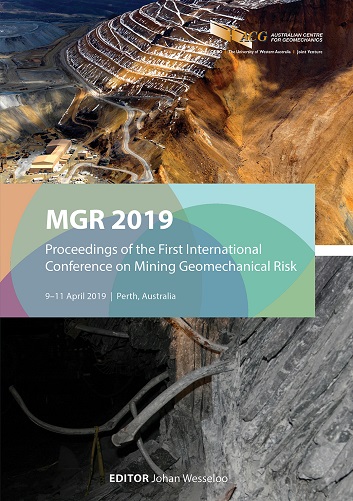Geotechnical value quantification through real options

|
Authors: Venter, J; Hamman, ECF |
DOI https://doi.org/10.36487/ACG_rep/1905_21_Venter
Cite As:
Venter, J & Hamman, ECF 2019, 'Geotechnical value quantification through real options', in J Wesseloo (ed.), MGR 2019: Proceedings of the First International Conference on Mining Geomechanical Risk, Australian Centre for Geomechanics, Perth, pp. 353-372, https://doi.org/10.36487/ACG_rep/1905_21_Venter
Abstract:
Slope stability acceptance criteria is often applied from standard tables representing industry practice or corporate risk tolerance. While in many cases such standard off-the-shelf solutions are fit for purpose, in the case of slopes with a high value increase per incremental slope angle increase, or where highcost infrastructure or other sensitive locations are nearby, it pays to have a custom Probability of Failure acceptance criteria determined through risk analysis. The value lies in being able to quantify the consequences of hazards that are slope angle driven, and in determining the mining schedule consequences of these hazards through Probability of Failure. This paper demonstrates the concept of the risk-based geotechnical assessment through a practical example of a small saprolite pit in West Africa, how such an analysis was carried out, and how the costappropriate risk controls were put in place. The example is based on a gold mine, and considers the timing and size of potential failure as well as the mining schedule and cash flow schedule. The type and size of appropriate risk controls are also estimated in the calculation. Finally, the paper demonstrates through the model how the value of geotechnical engineering controls can be calculated using the concept of real options.
Keywords: real option, economic risk, cash flow, slope stability
References:
Contreras, L & Tunono, A 2011, ‘Probabilistic stability analysis for pit slope optimisation at Jwaneng Mine, Botswana’, Civil Engineering, April 2011, pp. 53–56.
Contreras, L & Steffen, OKH 2012, ‘An economic risk-based methodology for pit slope design’, Australian Centre for Geomechanics Newsletter, December 2012, pp. 7–13.
Contreras, LF 2015, ‘An economic risk evaluation approach for pit slope optimisation’, Journal of the Southern African Institute of Mining and Metallurgy, vol. 115, no. 7, pp. 607–622.
Contreras, LF, Lesueur, R & Maran, J 2006, ‘A case study of risk evaluation at Cerrejon Mine’, Proceedings of the International Symposium on Stability of Rock Slopes in Open Pit Mining and Civil Engineering Situations, South African Institute of Mining and Metallurgy, Johannesburg.
Crundwell, FK 2008, Finance for Engineers: Evaluating and Funding Capital Projects, Springer-Verlag, London.
Hull, JC 2003, Options, Futures, and Other Derivatives, 5th edn, Prentice Hall, New Jersey.
Steffen, OKH, Contreras, LF, Terbrugge, PJ & Venter, J 2008, ‘A risk evaluation approach for pit slope design’, Proceedings of the 42nd US Rock Mechanics Symposium, American Rock Mechanics Association, Alexandria.
Terbrugge, PJ, Wesseloo, J, Venter, J & Steffen, OKH 2006, ‘A risk consequence approach to open pit slope design’, The Journal of the South African Institute of Mining and Metallurgy, vol. 106, pp. 503–511.
Venter, J & Hamman, ECF 2018a, ‘A temporal safety risk model for open pit slope management’, Proceedings of Slope Stability 2018, Asociacion Nacional de Ingenieros de Minas and Colegio Oficial de Ingenieros de Minas del Sur, Seville.
Venter, J & Hamman, ECF 2018b, ‘Determining the optimum slope angle using an integrated mine planning approach’, Proceedings of Slope Stability 2018, Asociacion Nacional de Ingenieros de Minas and Colegio Oficial de Ingenieros de Minas del Sur, Seville.
Wesseloo, J & Read, J 2009, ‘Acceptance criteria’, in J Read & P Stacey, Guidelines for Open Pit Slope Design, CSIRO Publishing, Collingwood, pp. 221–236.
© Copyright 2025, Australian Centre for Geomechanics (ACG), The University of Western Australia. All rights reserved.
View copyright/legal information
Please direct any queries or error reports to repository-acg@uwa.edu.au
View copyright/legal information
Please direct any queries or error reports to repository-acg@uwa.edu.au
